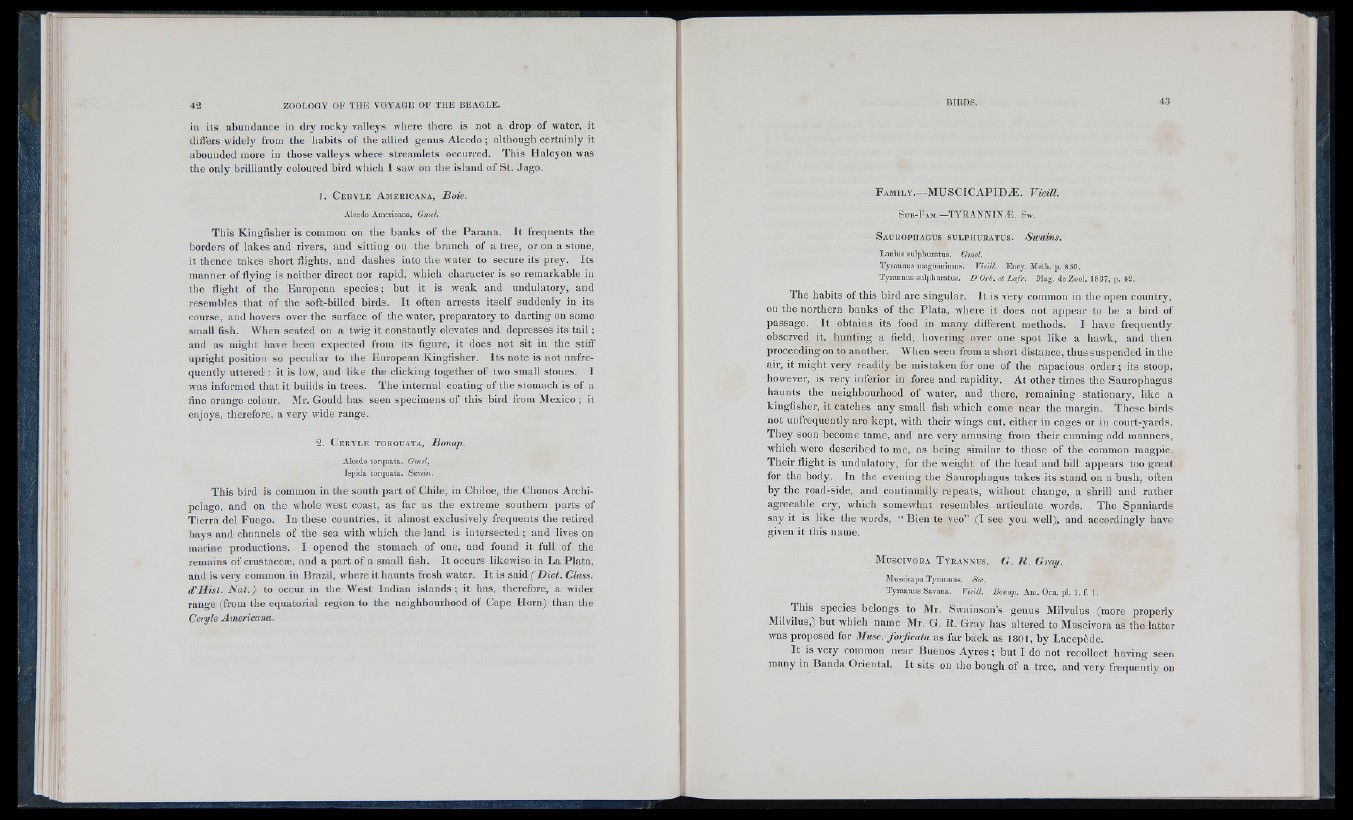
i;í
in its abundance in dry rocky valleys where there is not a drop of water, it
differs widely from the habits of the allied genus Alcedo; although certainly it
abounded more in those valleys where streamlets occurred. This Halcyon was
the only brilliantly coloured bird which I saw on the island of St. Jago.
1 . C e r y l e A m e r ic a n a , Boie.
Alcedo Americana, Gmel,
Tliis Kingfisher is common on the banks of the Parana. It frequents the
borders of lakes and rivers, and sitting on the branch of a tree, or on a stone,
it thence takes short flights, and dashes into the water to secure its prey. Its
manner of flying is neither direct nor rapid, which character is so remarkable in
the flight of the European species; but it is weak and undulatory, and
resembles that of the soft-billed birds. It often arrests itself suddenly in its
course, and hovers over the surface of the water, preparatory to darting on some
small fish. Wiien seated on a twig it constantly elevates and depresses its tai l ;
and as might have been expected from its figure, it does not sit in the stiff
upright position so peculiar to the European Kingfisher. Its note is not unfre-
quently uttered : it is low, and like the clicking together of two small stones. I
was informed that it builds in trees. The internal coating of the stomach is of a
fine orange colour. Mr. Gould has seen specimens of this bird from Mexico ; it
enjoys, therefore, a very wide range.
2 . C e r y l e t o r q u a t a , Bonap.
Alcedo torquata. Gmel,
Ispida torquata. Sicain.
This bird is common in the south part of Chile, in Chiloe, the Chonos Archipelago,
and on the whole west coast, as far as the extreme southern parts of
Tierra del Fuego. In these countries, it almost exclusively frequents the retired
bays and channels of the sea with which tlie land is intersected ; and lives on
marine productions. I opened the stomach of one, and found it full of the
remains of crustacese, and a part of a small fish. It occurs likewise in La Plata,
and is very common in Brazil, where it haunts fresh water. It is said ( Diet. Class.
J l l i s t . N a t.) to occur in the West Indian islands; it has, therefore, a wider
range (from the equatorial region to the neighbourhood of Cape Horn) than the
Ceryle Americana.
4.3
Family.—MUSCICAPTDÍE. Vieill.
Sub- F am.— T Y R A N N IN « . Sw.
S a u r o p h a g u s s u l p h u r a t e s . Sivains.
Lanius sulphuratus. Gmel.
Tyrannus magnanimus. Vieill. Ency. Meth. p. 8.50.
Tyrannus sulphuratus. B'Orh. et Lafr. Mag. do Zool. 18S7, p. 42.
The habits of this bird are singular. It is very common in the open country,
on the northern banks of the Plata, where it does not appear to be a bird of
passage. It obtains its food in many different methods. I have frequently
observed it, hunting a field, hovering over one spot like a hawk, and then
proceeding on to another. When seen from a sliort distance, thus suspended in the
air, it might very readily be mistaken for one of the rapacious order; its stoop,
however, is very inferior in force and rapidity. At other times the Saurophagus
haunts the neighbourhood of water, and there, remaining stationary, like a
kingfisher, it catclies any small fish which come near the margin. Tliese birds
not unfrequently are kept, with their wings cut, either in cages or in court-yards.
They soon become tame, and are very amusing from their cunning odd manners,
which were described to me, as being similar to those of the common magpie.
Their flight is undulatory, for the weight of the head and bill appears too great
for the body. In the evening the Saurophagus takes its stand on a bush, often
by the road-side, and continually repeats, without change, a shrill and rather
agreeable cry, which somewhat resembles articulate words. The Spaniards
say it is like the words, “ Bien te veo” (I see you well), and accordingly have
given it this name.
M u s c ív o r a T y r a n n u s , G. 11. Gray.
Muscícapa Tyrannus. Sw.
Tyrannus Savana. Vieill. Bonap. Am. Orn. pi. I, f. I.
This species belongs to Mr. Swainson’s genus Milvulus (more properly
Milvilus,) but which name Mr, G. R. Gray has altered to Muscívora as the latter
was proposed for 3Iusc. forficala as far hack as 1801, by Lacepéde.
It IS very common near Buenos Ayres ; but I d o not recollect having seen
many in Banda Oriental. It sits on the bough of a tree, and very frequently on